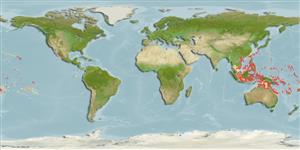>
Eupercaria/misc (Various families in series Eupercaria) >
Labridae (Wrasses) > Corinae
Etymology: Halichoeres: Greek, als, alis = salt + Greek, choiros = pig (Ref. 45335).
More on author: Bleeker.
Environment: milieu / climate zone / depth range / distribution range
Ecologia
marino associati a barriera corallina; distribuzione batimetrica 2 - 40 m (Ref. 9710). Tropical; 30°N - 24°S
Western Pacific: east to Samoa (Ref. 27362) and Tonga (Ref. 53797).
Size / Peso / Age
Maturity: Lm ? range ? - ? cm
Max length : 13.0 cm SL maschio/sesso non determinato; (Ref. 9823)
Short description
Chiavi di identificazione | Morfologia | Morfometria
Spine dorsali (totale) : 9; Raggi dorsali molli (totale) : 12 - 13; Spine anali: 3; Raggi anali molli: 12; Vertebre: 25. Anterior head and body color of adults in life bluish gray, shading posteriorly to yellowish; scales often with orange-yellow vertical lines; a dark spot posterior to dorsal half of eye; dorsal fin with a large black spot edged with blue. Anterior lateral line scales with 1-3 pores; 9-11 suborbital pores. Anterior dorsal and anal soft rays longer than posterior rays; pelvic fins of males and large females very long, reaching posterior to anus, often to or beyond origin of anal fin. Juveniles with 4 black stripes on head and body.
Inhabits lagoon and seaward reefs, in coral-rich areas (Ref. 9710). Also found along drop-offs on the bottom of large caves. Usually seen solitary (Ref. 48636).
Life cycle and mating behavior
Maturities | Riproduzione | Spawnings | Egg(s) | Fecundities | Larve
Distinct pairing during breeding (Ref. 205).
Randall, J.E., G.R. Allen and R.C. Steene, 1990. Fishes of the Great Barrier Reef and Coral Sea. University of Hawaii Press, Honolulu, Hawaii. 506 p. (Ref. 2334)
IUCN Red List Status (Ref. 130435)
Threat to humans
Harmless
Human uses
Can't connect to MySQL database (fbapp). Errorcode: Too many connections
